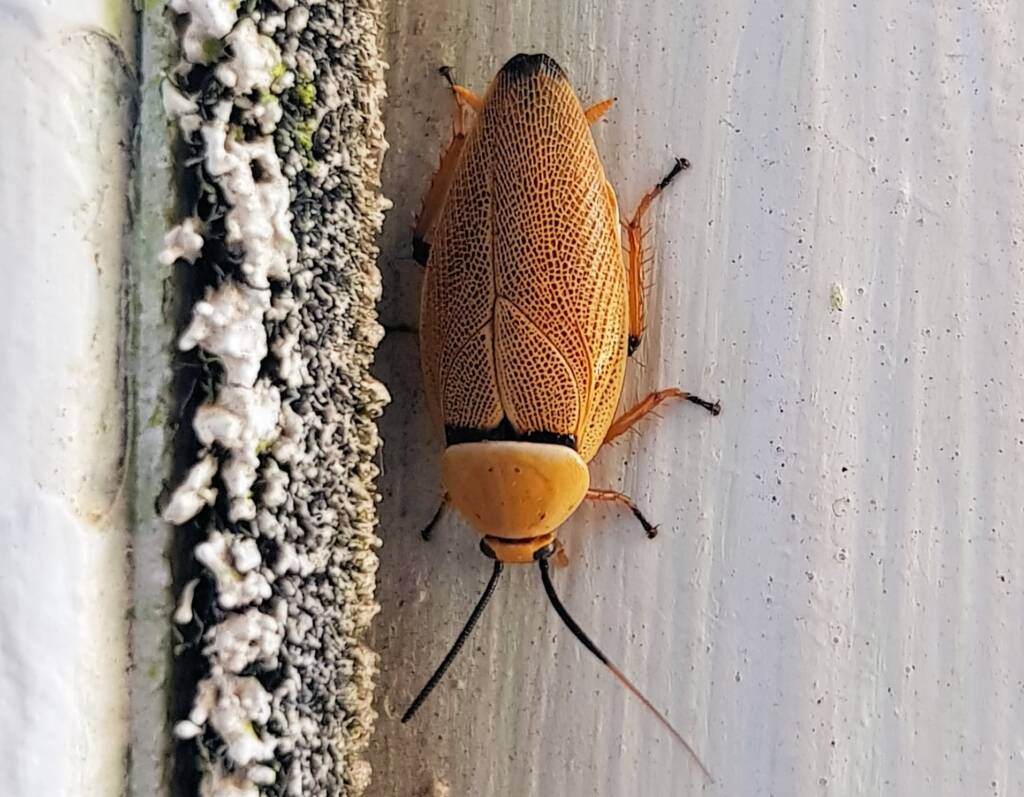BlattodeaAnamesia sp Balta bicolor Bush Cockroach Ellipsidion Ellipsidion australe Ellipsidion humarale Nasutitermes triodiae Termite — Alate
The order Blattodea are insects that contains cockroaches and termites.
There are a recognised over 400 species of cockroaches in Australia, with an estimate of some 4,000 species worldwide, in nearly 500 genera. There is about 3,000 species of termite in around 300 genera.

Of course in Australia, it is the introduced pest species that are the most well know, as they commonly inhabit where we live, eat and work — in our houses, restaurants and sewers.
Whilst the general form of cockroaches are similar, they can vary considerably in sizes across species. Cockroaches have the following characteristics1:
- they have an oval and flattened body shape
- the thorax is covered by a large plate (the pronotum), that extends partly over the head
- they have a chewing (mandibulate) mouthparts
- they have compound eyes and 2 simple ocelli-like spots
- 2 pairs of membranous wings when present. Forewings are more sclerotised than hind wings. Wings are folded left over right when at rest
- prominent cerci (extending from the rear end of a cockroach are two tapered appendages)
- long antennae

Termites are pale-coloured, soft-bodied eusocial insects that live in colonies, whereas cockroaches are darker-coloured (often brown), sclerotized, segmented insects. Within the colony, termites have a caste system, with a pair of mature reproductives, the king and the queen, and numerous sterile workers and soldiers. The cockroaches are not colonial but do have a tendency to aggregate and may be considered pre-social, as all adults are capable of breeding. Other similarities between the two groups include various social behaviours, trail following, kin recognition and methods of communication.

- Scientific classification
- Kingdom: Animalia
- Phylum: Arthropoda
- Class: Insecta
- Superorder: Dictyoptera
- Order: Blattodea
- Superfamilies:
- Corydioidea
- Blaberoidea
- Blattoidea
Footnote & References
- Blattodea: cockroaches, Insects and their Allies, CSIRO, https://www.ento.csiro.au/education/insects/blattodea.html
- Cockroaches: Order Blattodea, Australian Museum, https://australian.museum/learn/animals/insects/cockroaches-order-blattodea/
- Blattodea, Brunner von Wattenwyl, 1882, Cockroaches, Atlas of Living Australia, https://bie.ala.org.au/species/urn:lsid:biodiversity.org.au:afd.taxon:33aea6f8-ab16-4a2b-8b5f-8c430dcbf5e8
- Blattodea, https://en.wikipedia.org/wiki/Blattodea (last visited Feb. 13, 2022)
BlattodeaAnamesia sp Balta bicolor Bush Cockroach Ellipsidion Ellipsidion australe Ellipsidion humarale Nasutitermes triodiae Termite — Alate
InsectsBees Beetles Blattodea Butterflies Coleoptera Cicada Crabronidae Diptera Dragonflies & Damselflies Formicidae Hemiptera Heteroptera (True Bugs) Mango Planthopper Moths Orthoptera Orthopteroid Processionary Caterpillar Stink Bugs, Shield Bugs and Allies Syrphidae Wasps Water Scorpion (Laccotrephes tristis) Witchetty Grub
